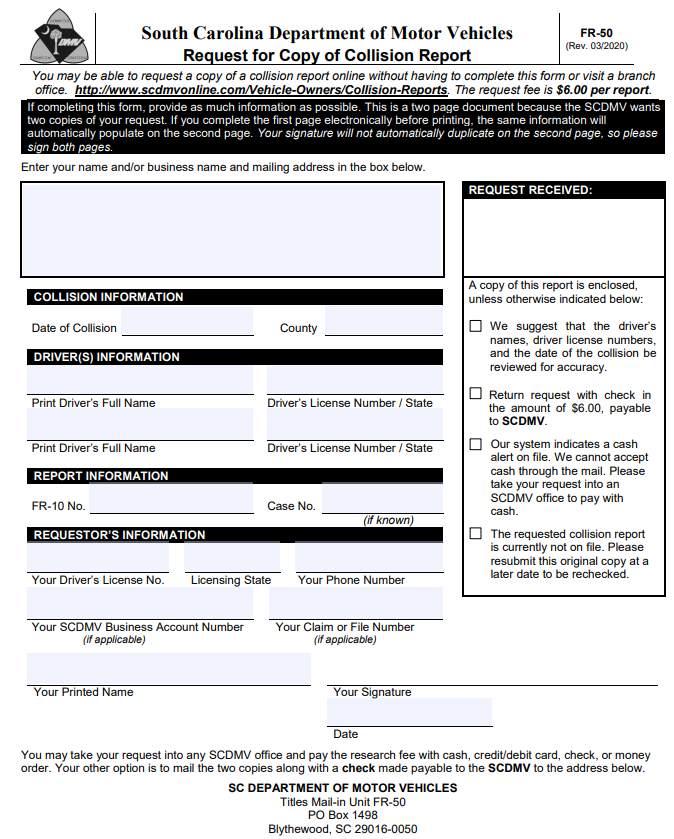A serious auto accident, truck accident, motorcycle accident, or commercial vehicle accident is a traumatic and tumultuous experience. Once the dust settles though, you will need to obtain a copy of the South Carolina motor vehicle accident report from the jurisdictional precinct of the reporting officer. A South Carolina Uniform Motor Vehicle Accident Report can be confusing. The police officers who draft accident reports are trained to use arcane symbols, coded words, and numbers to convey a multitude of information in just a couple of pages.
These reports are designed to provide a data record in a standard format — not to be an easy-to-read diagram for a layperson. Despite what can appear to be an overwhelming and confusing task, most South Carolina accident reports provide a reasonably comprehensive story of what happened in a car accident. One just needs to know where to look. Typically, in South Carolina, a police officer arrives on the scene after an accident has been reported and speaks with all the parties involved about their version of events. He or she may speak with witnesses if there are any and then draft up a South Carolina accident report from all the information gathered.
You are not allowed to look over the officer’s shoulder while the South Carolina accident report is being drafted. Most often, South Carolina accident reports are available within 5-7 business days after the accident. The reports are available at the police department or through a third-party website (such as BuyCrash.com) for purchase. Once you have the South Carolina accident report in hand, you will need to check it for accuracy. But first, it’s helpful to know what exactly you are looking at.
Sections of a South Carolina Uniform Motor Vehicle Accident Report
Page 1, Part 1
The top boxes give some basic information about the accident. The most important box is the top left, which is the report number. The police officer should give this number to all parties at the time of the accident. This is how you will find the completed report once it is ready. The next boxes list information such as date of incident, location, time, and whether or not this is the original accident report or a supplemental report. Should you need to alter any information on the accident report, the police officer will typically note that this has occurred. The top boxes typically are not something that gets a lot of disagreement.
Page 1, Part 2
The next section of the report typically contains detailed information about the drivers involved in the accident. This includes names, addresses, phone numbers, driver’s license numbers, and insurance information. It is crucial to check this section for accuracy as any mistakes could complicate the claims process. The officer will also note the make, model, year, and vehicle identification number (VIN) of the vehicles involved.
Page 2, Part 1
Page 2 often includes a diagram of the accident scene. This diagram is essential as it visually represents how the accident occurred according to the investigating officer. The diagram will show the position of the vehicles before, during, and after the collision. Pay close attention to this diagram to ensure it matches your recollection of the events. Any discrepancies should be noted and addressed with the reporting officer or through your legal counsel.
Page 2, Part 2
This section usually contains narrative descriptions provided by the drivers, passengers, and witnesses. The officer’s narrative will also be included, providing an account of the accident based on the gathered evidence and testimonies. This narrative can be crucial for understanding how the officer interpreted the events and can be vital for any legal proceedings or insurance claims.
Additional Sections
Some accident reports may include additional sections for information such as road conditions, weather conditions, and any citations issued. These details can play a significant role in determining liability and understanding the context of the accident. Ensure all information is accurately reflected and consistent with your experience of the incident.
Checking for Accuracy
Once you have the report, it is essential to review it thoroughly. Look for any errors in personal information, vehicle details, and the accident narrative. If you find discrepancies, contact the police department to request corrections. Accurate information is crucial for insurance claims and any potential legal action.
Using the Report
The South Carolina motor vehicle accident report is a critical document for your insurance claim and any legal proceedings. Provide a copy to your insurance company and keep one for your records. If you are pursuing a personal injury claim, your attorney will need this report to build your case. The report serves as an official record of the accident and can significantly impact the outcome of your claim.

